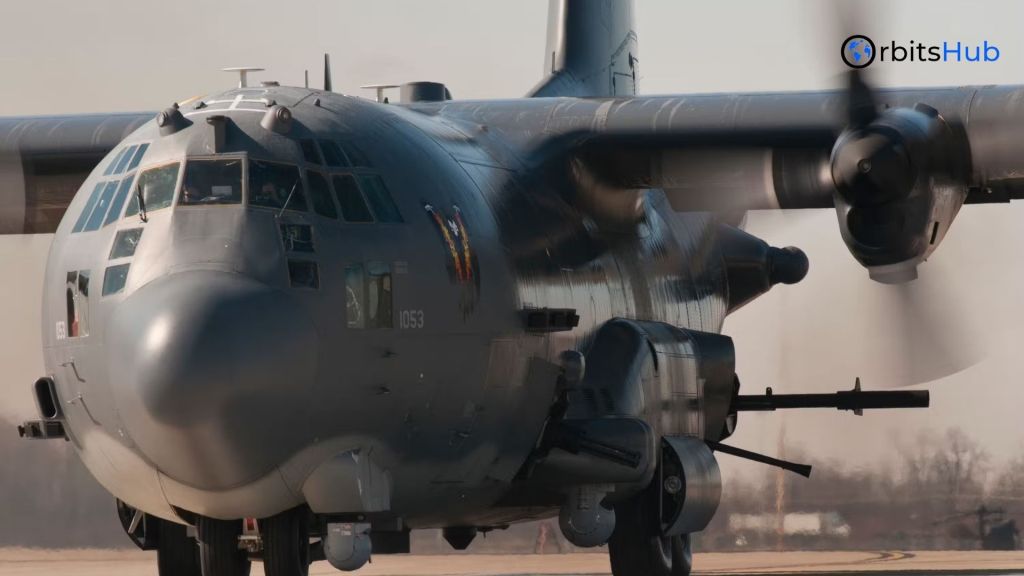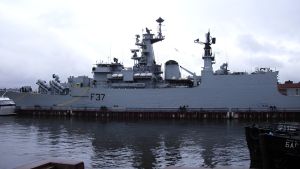The AC-130J Ghostrider is a force to be reckoned with in the skies. This heavily modified version of the iconic C-130J Super Hercules is a gunship that provides close air support, air interdiction, and armed reconnaissance capabilities for the United States Air Force Special Operations Command (AFSOC). If you’re interested in the world of military aviation, the AC-130J Ghostrider is a truly fascinating aircraft, so buckle up as we take a deep dive into its features and functionalities.
A Legacy of Gunships
The AC-130 concept has existed since the Vietnam War, when heavily armed C-47 Skytrain aircraft, nicknamed “Spooky,” provided close air support for ground troops. The AC-130J Ghostrider is the latest evolution of this gunship lineage, offering a more robust and versatile platform.
AC-130J: The Ghostrider’s Transformation

The C-130J Super Hercules is a baseline four-engine turboprop aircraft known for its versatility in cargo and troop transport missions. The AC-130J takes this platform and transforms it into a flying arsenal. Here’s a breakdown of the critical modifications:
- Advanced Avionics: The Ghostrider boasts a state-of-the-art two-pilot flight station with fully integrated digital avionics. This ensures precise navigation and situational awareness for the crew during operations.
- Precision Strike Package: This suite of modifications is the heart of the Ghostrider’s firepower. It includes a mission management console, a robust communications suite, and advanced fire control equipment.
- Sensor Systems: Two electro-optical/infrared (EO/IR) sensors provide the crew with high-resolution day and night vision for target identification and engagement.
- The Big Guns: This is where things get interesting. The AC-130J packs a serious punch with its main armament:
- A devastating 105mm cannon can deliver heavy firepower against enemy positions.
- A 30mm GAU-23/A Bushmaster autocannon for shredding lighter targets and vehicles.
Beyond the Cannons: The Ghostrider’s arsenal continues beyond its main guns. It can also be equip with:
- Guided Munitions: The aircraft can carry and deploy precision-guided munitions, such as GBU-39 Small Diameter Bombs and AGM-114 Hellfire missiles, for surgical strikes.
- Loitering Munitions: These uncrewed aerial vehicles (UAVs) can stay aloft for extended periods, providing persistent surveillance and the ability to engage targets with their onboard weaponry.
The Ghostrider in Action: AC 130 Lockheed
The AC-130J’s primary function is to provide close air support for troops on the ground. Imagine a scenario where friendly forces are pin down by enemy fire. The Ghostrider can arrive overhead, using its sensors to identify enemy positions and unleash its devastating firepower to neutralize the threat.
The Ghostrider’s capabilities extend beyond close air support. It can also be used for:
- Air Interdiction: This involves hunting down and destroying enemy forces or resources before they reach their objective.
- Armed Reconnaissance: Over a large region, the Ghostrider’s sensors can collect intelligence on the whereabouts and actions of enemies.
The AC-130J’s unique combination of firepower, sensor systems, and operational flexibility makes it a valuable asset for the AFSOC, providing critical airpower in various situations.
Lockheed AC-130j: Eyes in the Sky, Fingers on the Trigger
This section can delve into the crew composition and their crucial roles in operating the AC-130J effectively. You can break it down like this:
- Pilots: Responsible for safe and precise aircraft navigation during operations, often in demanding night-time or low-visibility conditions.
- Combat Systems Officers (CSOs): Act as mission commanders, coordinating tactics, target identification, and weapon deployment.
- Sensor Operators: Utilize the EO/IR sensors to provide real-time visual data to the crew, ensuring accurate target acquisition and engagement.
- Special Mission Aviators (SMAs): These highly trained enlisted personnel directly operate the weapon systems, firing the cannons and launching munitions with pinpoint accuracy.
The Future of Gunships: How Will the AC-130J Evolve?

This section can explore potential future advancements for the AC-130J platform. Here are some interesting points to consider:
- Integration of Artificial Intelligence (AI): AI could assist with tasks like target identification, threat prioritization, and fire control, potentially reducing crew workload and improving battlefield decision-making.
- Advanced Weapon Systems: Future iterations might incorporate more powerful cannons, longer-range missiles, or directed-energy weapons.
- Enhanced Situational Awareness: Upgraded sensor suites and integration with battlefield networks could give the Ghostrider a more comprehensive battlespace picture.
By including these additional sections, you can create a more comprehensive and informative picture of the AC-130J Ghostrider, making it even more engaging for readers interested in this impressive aircraft.
The AC-130J Ghostrider is a testament to American military innovation. It represents a powerful and versatile gunship that supports troops on the ground. While its primary function lies in offensive operations, the Ghostrider’s presence can also serve as a deterrent, discouraging enemy aggression.
Are you intrigue by the world of maritime and aviation technology? Explore Orbitshub to discover a wealth of information and consultancy services related to these dynamic industries. From in-depth analyses of cutting-edge aircraft like the AC-130J to expert advice on maritime operations and regulations, OrbitsHub can be your one-stop shop for all things marine and aviation.




